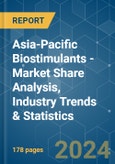The Asia-Pacific Biostimulants Market size is estimated at USD 0.78 billion in 2024, and is expected to reach USD 1.27 billion by 2029, growing at a CAGR of 10.24% during the forecast period (2024-2029).
Key Highlights
- Amino Acids is the Largest Form : Amino acids are the most used biostimulants in the region, because of their importance in enhancing plant productivity, especially under abiotic and biotic stress conditions.
- Humic Acid is the Fastest-growing Form : Humic acid biostimulants are component of humus and capable to bind insoluble metal ions, oxides, and hydroxides and to release them slowly to plants when required.
- Row Crops is the Largest Crop Type : The major row crops cultivated in the Asia-pacific Region include rice, wheat, canola, barley, corn, and soybeans. Amino acids are most consumed biostimulants in row crops.
- China is the Largest Country : Humic acids are the most consumed biostimulants in the country with 25.3% in 2022, and row crops are dominating biostimulants market in the country with 82.3% in 2022.
APAC Biostimulants Market Trends
Amino Acids is the largest Form
- Modern agriculture plays a central role in solving some of humanity's most challenging problems. As the population in the Asia-Pacific region grows, the agricultural sector is under pressure to meet the rising demand for food and achieve food security goals.
- The deterioration of soil quality has become a major concern among farmers and agriculturists in the region. This has resulted in a loss of fertility, biodiversity, and production capacity. The agriculture sector's most significant challenge is the increasing use of synthetic fertilizers and pesticides to boost agricultural production. According to studies, excessive fertilizer use could hasten the climate crisis.
- As a result, environmentally friendly and sustainable farming practices with innovative solutions are now standard practices in modern agriculture. To ensure adequate food production, the agricultural sector must embrace new solutions and approaches to improve resource utilization efficiency. Biostimulants have emerged as an environmentally friendly and promising innovation for modern agriculture in this regard. Amino acids, humic acid, fulvic acid, seaweed extract, and protein hydrolysates are among the most commonly used biostimulants.
- Amino acids are the most commonly used biostimulants in the Asia-Pacific region, with the largest market share of 25.2% in 2022. This is due to their ability to enhance plant productivity, especially under abiotic and biotic stress conditions.
- Major agricultural countries in the region, such as India and China, have launched various initiatives to promote organic farming and the use of sustainable agricultural inputs. They offer various incentives that may drive the market, and as a result, the market value is anticipated to record a CAGR of 11.9% between 2023-2029.
China is the largest Country
- The Asia-Pacific region has witnessed a remarkable increase in the demand for organically grown food, resulting in a surge in the biostimulants market. With countries like India, China, Australia, and Japan promoting organic farming, the area under organic cultivation increased from 3.1 million hectares in 2017 to 3.8 million hectares in 2022. As a result, the biostimulants market experienced a growth rate of 11.5% between 2017-2022.
- The impact of climate change has severely affected crop production, making it imperative to use biostimulants to mitigate climate-induced stresses like drought, salinity, and temperature variations. The application of biostimulants has proven to have a positive impact on plants and helps maintain the ecological balance of agroecosystems, reducing the need for pesticides and chemical fertilizers.
- China, India, and Australia have emerged as the major business areas for biostimulants in the Asia-Pacific region. In 2022, China dominated the biostimulants market with a 27.6% share, followed by India and Australia. The governments of these countries are encouraging farmers to adopt sustainable agricultural practices by providing incentives, investing in research and development, and setting targets to meet. For instance, Japan has set a goal to reduce the usage of chemical fertilizers and pesticides by 30.0% and 50.0%, respectively, by 2050.
- The demand for biostimulants in the Asia-Pacific region is on the rise due to the increasing area under organic farming and the need for sustainable agricultural practices. The biostimulants market in the Asia-Pacific region is expected to witness further growth in the coming years, with the potential to help combat the adverse effects of climate change on agriculture.
APAC Biostimulants Industry Overview
The Asia-Pacific Biostimulants Market is fragmented, with the top five companies occupying 8.79%. The major players in this market are Biolchim SpA, Biostadt India Limited, Gujarat State Fertilizers & Chemicals Ltd., T. Stanes and Company Limited and Valagro (sorted alphabetically).Additional Benefits:
- The market estimate (ME) sheet in Excel format
- 3 months of analyst support
Table of Contents
1 EXECUTIVE SUMMARY & KEY FINDINGS2 REPORT OFFERS7 KEY STRATEGIC QUESTIONS FOR AGRICULTURAL BIOLOGICALS CEOS
3 INTRODUCTION
4 KEY INDUSTRY TRENDS
5 MARKET SEGMENTATION
6 COMPETITIVE LANDSCAPE
8 APPENDIX
Companies Mentioned (Partial List)
A selection of companies mentioned in this report includes, but is not limited to:
- Agrinos
- Atlántica Agrícola
- Biolchim SpA
- Biostadt India Limited
- Coromandel International Ltd
- Gujarat State Fertilizers & Chemicals Ltd.
- Plant Response Biotech Inc.
- Rallis India Ltd
- T. Stanes and Company Limited
- Valagro
Methodology

LOADING...










